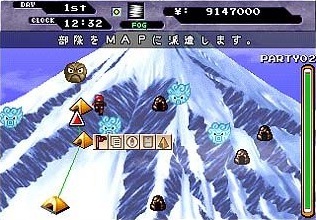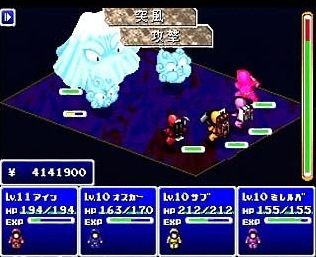|
|

|
PLATFORM
|
PSX
|
BATTLE SYSTEM
|

|
INTERACTION
|

|
ORIGINALITY
|

|
STORY
|

|
MUSIC & SOUND
|

|
VISUALS
|

|
CHALLENGE
|
Unbalanced
|
LANGUAGE BARRIER
|
Minimal
|
COMPLETION TIME
|
Less than 20 Hours
|
|
OVERALL

|
+ Absolutely unique
+ Fun variety of monsters
- Extreme difficulty spikes
- No story to speak of
- No way to upgrade characters
|
Click here for scoring definitions
|
|
|
For the better part of two decades, D3 Publisher's Simple Series has filled an interesting niche in the gaming landscape. They offered low-budget games of every genre at bargain-bin prices ranging from 1500 yen to 2500 yen (about 15 to 25 dollars). There have been hundreds of titles produced, and a few among them did so well that they went on to become successful franchises. This review is not about any of those games. Instead, we look at one of the weird relics of the PSX library, The Tozan (Mountaineering) RPG: Challengers of the Silver Peak.
The story deserves a quick blurb, but not much else. Six great mountains across the globe have suddenly turned monstrous, spawning hordes of strange creatures that attack all who come close. The International Mountaineering Society has put the call out for its most experienced members to gather and assail the peaks in order to put an end to the menace. And... that's about it. This game has a setup, but no follow through: no plot, no characters, not even an ending worthy of mention. While the player will have plenty of mountaineers on hand, they're just names attached to color-coded snowsuits, with no personality or other distinguishing features beyond their specified class.
More than an RPG, this game is a strategy title in the vein of the original Ogre Battle. The player is in charge of putting teams together, sending them out, and determining their routes, but combat is on auto-pilot. Each of the four member classes has a use. Attackers hit hardest, and are required for a group to challenge the peak (boss) of each level. Climbers are fast, and speed up the ascent. Nurses are obviously healers, but also dole out stat ups from the back row or stat downs on enemies when on the front. Finally, Sherpas have the highest health and defense, can take hits for teammates, and are needed if a group is to set up a campsite. The three attacking classes also have different front and back row special attacks that trigger from time to time, with activation rates increasing sharply when facing stronger monsters. In keeping with the theme, instead of weapons the mountaineers attack with hammers, picks, shovels, pitons, crampons, carabiners, and the entire contents of a Sherpa's knapsack. It's pretty hilarious at times. Sadly, aside from the basic stat increases there is no real character advancement in this game. The four classes are all the player has at his or her disposal, with no optional equipment or upgrades.
 The Grand Old Duke of York...
The Grand Old Duke of York...
|
|
What the player does have are communication devices. Each of these four items costs a good deal of money to use, but the effects are life-saving. With one call, the player can summon supply crews for healing or rescue helicopters armed to the teeth. There's even a dog whistle that summons a pack of ravenous sled dogs to rip the enemy to shreds. As mentioned, these devices cost money to use, but this makes sense as money is a stand-in for overall team stamina and MP in this game. Keeping groups on the mountain costs cash at regular intervals, but the rewards for conquering a peak in good time help to refill the coffers nicely. It helps that all levels are replayable, so the player can go back and S-Rank Mt. Fuji for some quick cash if necessary. There are also caves that can be spelunked for extra monetary benefits, but these tend to be off the beaten path and not worth the effort.
 He had ten thousand Sherpas...
He had ten thousand Sherpas...
|
|
The variety of enemies is rather impressive, especially when compared to the handful of human classes. While some are obvious choices, like the Yetis, Snow Women, vampires, and revenant mountaineers, most are the physical incarnations of real-life mountain climbing hazards. Gale spirits blast with wind while Deep Fog chills with its White-Out attack. Falling Rocks and Avalanches pile damage upon the party, while the ghostly Altitude Sickness attempts to sow confusion. And then there's the Crevasse, which is a long crack in the ground partnered with two eyes to form a twisted smiley face. The six great peaks themselves are impressive foes, and the sub-boss for each zone is no slouch, either. Later bosses have literal mountains of hit points and attacks ranging from confusion-causing aurorae to snowballistic missiles. Faced with that, no group of brave mountaineers can survive for long.
 He pitted them 'gainst Mt. Fuji, for no discernable purpose...
He pitted them 'gainst Mt. Fuji, for no discernable purpose...
|
|
This is where a lot of the strategy comes into play. If a party is wiped out, they're stranded at that point on the map until another group can help them return to the nearest campsite or (if twenty-four hours pass) a helicopter crew will return them all the way to the base camp for a hefty sum. Any group with a Sherpa in it can set up a camp, which any other nearby group can utilize to regain health and morale. Morale is measured by the spirit bar on the right side of the screen, and it steadily decreases as the party trudges upslope. Combat will make it change even faster, with character knockouts cutting it down and enemy deaths bringing it up. If the bar ever reaches zero, then that team is sent all the way to base camp, so tactical retreats are often a good strategy to avoid losing too much ground. If a group runs away from battle (at the player's command), then they retreat to the nearest campsite, so it's in the player's best interests to create a series of fallback positions, since the game's difficulty can be really unbalanced at times.
The Tozan RPG takes an interesting concept and a surprisingly robust basic game engine and then fails to do much of anything with it. There's no story or other motivation of any sort, and nothing really distinguishes any of the mountaineers beyond their basic uses. The game as it stands would make an excellent base camp for an RPG excursion like no other, but it never gets above the alpine line. The sole reason to attempt this title is simply because it is there, which for a game centered on mountain climbing is actually appropriate. At perhaps ten hours in length, it'll be a short journey, at least.
Review Archives
|









